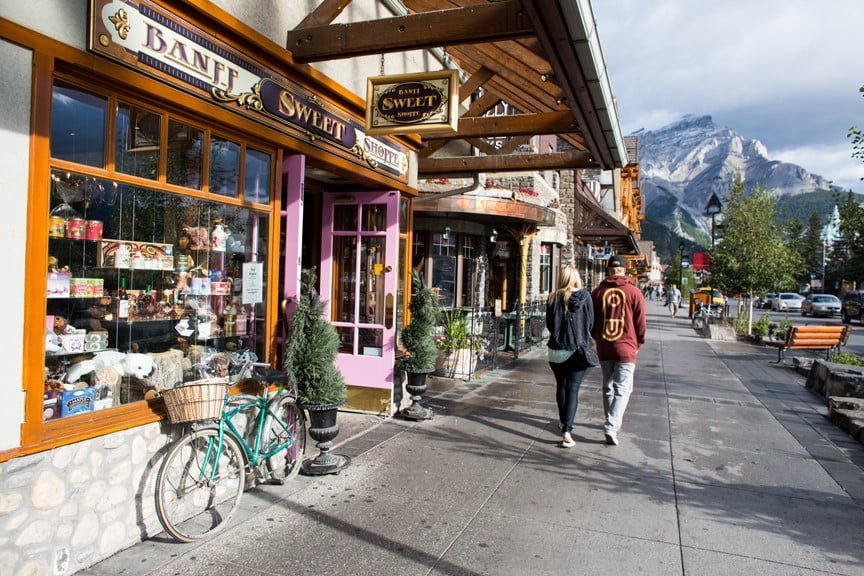One of the hardest hit industries from the COVID-19 pandemic is the tourism sector and one area of Canada that has particularly felt that blow is Banff, Alberta, which relies heavily on visitors spending money in restaurants, hotels, retail stores, and other places of business.
“The Banff economy is 90 percent based on tourism and many stores and restaurants are just hanging on at this point as the pandemic drags on,” said Michael Kehoe, a retail specialist in the area and broker/owner of Fairfield Commercial Real Estate.

“The ‘rubber-tire’ market made of visitors from Alberta and Saskatchewan may not be enough to save the 2021 summer season. The international visitors are what is needed along with conferences and events, like weddings, to drive a full recovery in the all-season resort markets and mountain towns like Banff.”
According to Banff & Lake Louise Tourism, tourism is the hardest hit sector of economic activities and the Banff area is unique in that its sole industry is tourism.
The current situation facing the tourism sector in Canada is the worst we have ever seen — more dire than the impact experienced after 9/11, SARS, and the 2008 economic crisis combined. One in 10 Canadian jobs is tied to tourism.
Banff and Lake Louise businesses are continuing to struggle — hotel occupancy rates in 2020 were down approximately 50 percent and revenue was down 60 percent. 2021 is also off to a slow start amidst restrictions with hotel occupancy down 63 percent.
Angela Anderson, spokesperson for Banff & Lake Louise Tourism, said the past year has definitely been the most challenging one probably ever.

“Tourism is the hardest hit sector in the economy. Our community in Banff and Lake Louise is really unique in that it’s sole industry is tourism. The town site was built to support visitation to the National Park. So everybody here works in tourism,” said Anderson.
“This situation is definitely the worst that we’ve ever seen. It’s more dire than what we experienced after 9/11, SARS, and the 2008 economic crash combined. It was a very, very intense year to go through.”
According to Banff & Lake Louise Tourism, in 2018, the Town of Banff generated $3.1 billion in spending in Alberta (this includes spending in Calgary as people arrive at the airport then head to Banff).
In a usual year, more than four million people come to Banff National Park and more than 80 percent visit the Town of Banff, where a majority of retail stores are located, as well as in Lake Louise.
Here is some accommodation data for Banff supplied by Travel Alberta for last year :
- Average Daily Room Rate: $207 (compared to $269 in 2019, a drop of 22.8 percent);
- Occupancy rate: 38 percent (compared to 70.4 percent in 2019, a drop of 46 percent);
- Revenue per Available Room: $79 (compared to $189 in 2019, a drop of 58.4 percent);
- Revenue: Room revenue decreased by $216.95 million to $119.9 million, a drop of 64.4 percent compared to 2019; and
- Supply/demand: Room supply decreased by 14.5 percent, but room demand plummeted by 53.9 percent.
Whether it’s a restaurant, a hotel, or a retail shop, many businesses in the tourist area are hanging by a thread if they are still operating.
“We know that our member businesses are really struggling right now. One thing that we’re not really used to do but we’ve been focusing on with other partner organizations is just really asking the governments at all levels for supports for our region and for the tourism industry,” said Anderson. “Those supports are absolutely crucial and those are what are helping businesses survive right now.
“And it’s not enough. There’s definitely more needed and so we continue to ask for support for businesses. That said, there is some optimism going into this summer . . . and we will absolutely be relying on Canadians and regional visitation to help our businesses get through this summer.
“Pending what’s happening in the different provinces with restrictions and cases, that should be a priority. Getting those under control for the health safety of Canadians is definitely the priority, but hopefully, we’re still very hopeful, that that will come under control with vaccinations and as we move forward in the coming weeks, we still are very hopeful that Canadians will be able to travel to Banff and Lake Louise this summer and we will absolutely be counting on them to help us save the summer essentially.”
The Town of Banff recently announced that it will be closing the 100 and 200 blocks of Banff Avenue and a portion of Caribou Street to vehicle traffic this summer in an attempt to provide tourists and residents with more space to practice COVID-19 safety measures and retailers and restaurants with the option to extend their presence onto the street.
Very quickly after the initial announcement, Banff Town Council altered the original date set to mobilize the Downtown Pedestrian Zone from June 12 to April 30.









What about Jasper? The town should have been included. I am sure it is being hit hard as well.